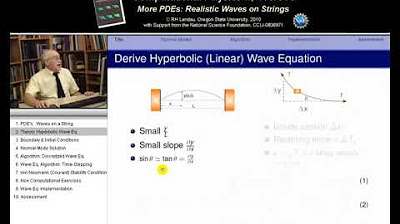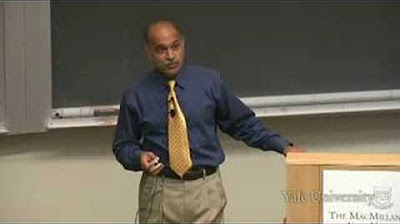21.3 Waves on a Catenary with Friction
TLDRThis lecture delves into the complexities of wave behavior on strings, extending the basic wave equation to incorporate friction and gravity for a more realistic approach. It introduces the concept of variable tension along the string and explores the catenary shape under gravity's influence. The speaker encourages students to engage with the material by coding and experimenting with different scenarios, aiming to understand the effects of these factors on wave propagation and stability. The goal is to provide a deeper insight into the physics of wave dynamics and to demonstrate the power of numerical methods in solving complex problems.
Takeaways
- 📚 The lecture is a continuation of the discussion on waves on strings, emphasizing the importance of understanding the previous material.
- 🌱 The wave equation on a string is extended to include friction and gravity for a more realistic model, moving beyond the simple linear equations found in textbooks.
- 💻 The inclusion of friction and gravity is demonstrated to be feasible through numerical methods, highlighting the utility of computers in handling complex problems.
- 🔍 Friction is incorporated into the wave equation using Newton's law, with a focus on viscous friction that is proportional to the velocity of the string.
- 📉 The effect of friction is to dampen the oscillations of the string, an important consideration for realistic simulations of wave behavior.
- 🌊 The lecture introduces the concept of variable tension along the string, which can affect wave propagation speed and is influenced by factors like gravity and string density.
- 📐 The wave equation is modified to account for the varying tension and density, leading to a more complex but realistic model for wave behavior on strings.
- 📈 The algorithm for solving the wave equation with variable tension is outlined, involving a leapfrog time-stepping method and central difference approximations for derivatives.
- 📉 The lecture discusses the physical implications of including gravity, such as the catenary shape a string takes under its influence, and how this affects wave propagation.
- 🎛 The equilibrium shape of a string under gravity is derived, showing that it follows a hyperbolic cosine function, with tension and density varying accordingly.
- 🔬 Encouragement is given for students to explore the effects of friction, gravity, and variable tension through coding exercises, including checking for stability and observing non-uniform damping.
Q & A
What is the main topic discussed in the video script?
-The main topic discussed in the video script is the extension of the wave equation on strings, including factors such as friction, gravity, and variable tension and density.
Why is it important to consider friction in the wave equation for strings?
-Friction is important to consider because it is a natural factor that causes the vibration of strings to decay over time, making the problem more realistic and reflective of real-world scenarios.
What type of friction model is used in the script?
-The script uses a viscous friction model, where the frictional force is proportional to the velocity of the string element and opposes the direction of motion.
How does the inclusion of friction in the wave equation affect the solutions?
-The inclusion of friction in the wave equation leads to solutions where the wave oscillates and then decays, which is a more realistic representation of how strings behave in real life.
What is the significance of considering variable tension and density in the wave equation?
-Variable tension and density allow for a more accurate modeling of real strings, such as those that might be found in musical instruments or physical structures, where the properties can change along the length of the string.
How does the script suggest modifying the wave equation to include variable tension and density?
-The script suggests using Newton's law (F = ma) and modifying the force term in the wave equation to account for the change in tension and density along the string.
What is the catenary shape mentioned in the script, and why is it relevant to the study of strings under gravity?
-The catenary shape is the static shape of a string, wire, or chain under the influence of gravity, and it is relevant because it represents the equilibrium shape of a string when it is not being plucked or vibrated.
How does the script suggest exploring the effects of gravity on wave propagation in strings?
-The script suggests modifying the wave equation to include the catenary shape and the variable tension resulting from gravity, and then observing the effects on wave propagation through simulations.
What numerical methods are hinted at in the script for solving the wave equation with additional complexities?
-The script suggests using numerical methods such as finite difference approximations to discretize the wave equation and develop an algorithm for solving it with the added complexities of friction, gravity, and variable properties.
What kind of physical phenomena should one look for when exploring the solutions of the modified wave equation?
-One should look for phenomena such as non-uniform damping, where the damping effect varies along the string, and the existence of normal modes or standing waves in the more complex system.
How does the script encourage learners to engage with the material?
-The script encourages learners to engage with the material by suggesting they modify existing code to include the new complexities, explore different cases, and observe the physical outcomes, such as the behavior of standing waves and the effects of non-uniform damping.
Outlines
📚 Introduction to Waves on Strings with Friction and Gravity
This paragraph introduces the topic of waves on strings, emphasizing the importance of understanding the previous lecture on strings. The speaker outlines the agenda for the session, which includes discussing the wave equation on a string while incorporating friction and gravity. The goal is to extend the simple linear wave equation to a more realistic model using numerical methods. The paragraph also highlights the limitations of purely analytical solutions and the benefits of using computers for handling complex, realistic cases.
🔍 Analyzing Friction's Impact on Wave Equations
The speaker delves into the specifics of including friction in the wave equation for strings. Friction is a crucial factor in the decay of string vibrations and is modeled as a viscous force proportional to the velocity of the string element, with a constant 'kappa'. The direction of friction is opposite to the motion, and its magnitude depends on the length of the string element and its velocity. The paragraph explains how to incorporate this frictional force into Newton's law, resulting in an adjusted wave equation that accounts for energy dissipation.
🔧 Modifying the Wave Equation with Variable Tension
The discussion moves on to variable tension along the string, which affects the wave propagation speed. The speed of a wave is the square root of the tension divided by the density, and if either varies, it impacts the wave's behavior. The speaker suggests an adiabatic approximation for cases with gradual variation and then proposes solving the problem without approximation by directly including variable tension in the wave equation. The paragraph also introduces the concept of density variation and its impact on tension distribution along the string.
📐 Incorporating Gravity and Catenary Shape in String Analysis
This paragraph introduces the effects of gravity on the string's tension and equilibrium shape, known as the catenary shape. The speaker explains that the tension in the string is not constant due to the weight of the string itself, especially noticeable in the middle of the string where it only supports its own weight. The paragraph outlines the process of deriving the wave equation with variable tension and density, leading to a more complex finite difference form of the equation that requires a leapfrog algorithm for solution.
🌐 Exploring the Dynamics of Strings with Variable Properties
The speaker discusses the solution for the equilibrium shape of a string under gravity, which is a hyperbolic cosine function, and the corresponding tension variation along the string. The paragraph provides a detailed explanation of how to derive the motion of the string with realistic functional dependencies for tension and density. It also suggests exploring the effects of these variations on wave propagation, such as non-uniform damping and the existence of normal modes.
🚀 Conclusion and Encouragement for Exploration
In the concluding paragraph, the speaker summarizes the enhancements made to the wave equation by including friction, gravity, and variable tension and density. They encourage students to modify the provided code to explore these effects and to visualize the solutions through surface plots and animations. The goal is to gain a deeper understanding of the physics involved and to observe phenomena like non-uniform damping and the behavior of normal modes in more complex scenarios.
Mindmap
Keywords
💡Wave Equation
💡Friction
💡Gravity
💡Tension
💡Catenary
💡Damping
💡Numerical Solution
💡Newton's Law
💡Finite Element
💡Leapfrog Algorithm
💡Normal Modes
Highlights
Introduction to the logical extension of the wave equation on strings, including friction and gravity.
Analytical limitations of solving the wave equation purely analytically, highlighting the benefits of numerical solutions.
The inclusion of friction in the wave equation using Newton's law and the concept of viscous friction.
Friction's impact on wave shape and the importance of modeling it in the wave equation.
The modeling of frictional force as proportional to the velocity of the string with an opposing direction.
Incorporating the length of the string element in the frictional force equation.
The challenge of solving the wave equation with friction and the suggestion to modify existing code.
Verification of the wave equation solution by checking the decay of oscillations and the effect of varying friction.
The exploration of physical instability in the wave equation when friction is negative.
The effect of variable tension in the wave propagation and its relation to the speed of the wave.
The derivation of the wave equation with variable tension and its implications for wave speed.
The consideration of gravity's impact on tension variation along the string.
The development of an algorithm for solving the wave equation with variable tension.
The analytical form of density and tension variation for a trial case with exponential functions.
The discrete form of the wave equation with variable tension and its implementation as a leapfrog algorithm.
The exploration of standing wave solutions in systems with variable density and tension.
The catenary shape of a string under gravity and its impact on wave propagation.
The solution for the equilibrium shape and tension of a string under gravity using hyperbolic cosine functions.
The final wave equation incorporating friction, gravity, and variable tension and density.
The practical application of the wave equation in exploring interesting physics such as non-uniform damping.
The encouragement to explore the existence of normal modes in complex wave equations.
Transcripts
Browse More Related Video
5.0 / 5 (0 votes)
Thanks for rating:





